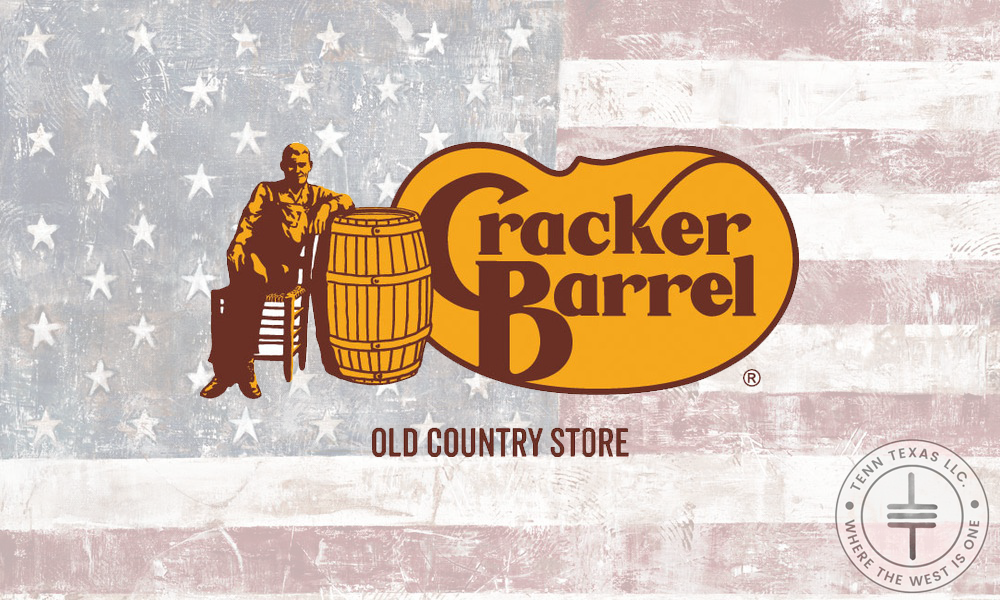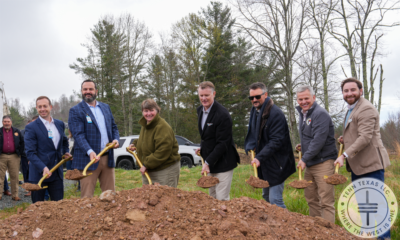FOOD & TRAVEL
CRACKER BARREL PROVIDES UPDATE ON STRATEGIC TRANSFORMATION PLAN AND ANNOUNCES CAPITAL ALLOCATION CHANGE TO DRIVE SUSTAINABLE LONG-TERM VALUE CREATION
Organic growth investments expected to accelerate financial performance in late fiscal 2026 and into fiscal 2027; Company provides update on third and fourth quarter fiscal 2024
Published
11 months agoon
By
Christina
LEBANON, Tenn., May 16, 2024 /- Cracker Barrel Old Country Store, Inc. (“Cracker Barrel” or the “Company”) (Nasdaq: CBRL) today provided an update on its strategic transformation plan and announced changes to its capital allocation.
Highlights
- The Company’s strategic transformation plan is anchored on three overarching business imperatives: driving relevancy, delivering food and an experience guests love, and growing profitability.
- To realize these imperatives, the Company has developed a comprehensive strategy focused on refining the brand, optimizing the menu, evolving the store and guest experience, winning in digital and off-premise, and elevating the employee experience.
- In conjunction with this plan, the Company is modifying its capital allocation to support increased investment in the business to drive organic growth. As part of this shift to increase investment in the business, the Company has reduced its quarterly dividend to $0.25 per share.
- The Company provided a long-term outlook and expects fiscal 2027 sales of approximately $3.8 billion to $3.9 billion and adjusted EBITDA1 of approximately $375 million to $425 million. The Company anticipates adjusted EBITDA1 in fiscal 2025 will be relatively in line with, or slightly lower than, fiscal 2024 results and will then improve in the second half of fiscal 2026 and further accelerate in fiscal 2027.
- The Company expects its third and fourth quarter fiscal 2024 financial results will be below its previous expectations, primarily due to weaker than anticipated traffic.
Cracker Barrel President and Chief Executive Officer Julie Masino commented: “I am excited about our strategic transformation plans to drive relevancy, deliver food and experiences guests love, and grow profitability. Cracker Barrel is an iconic brand with an exceptionally strong foundation, and I firmly believe our plans will allow us to capitalize on our strengths and deliver long-term success. Executing this strategy will require increased investment in our business, and we have reduced our dividend so that we can allocate capital to generate organic growth and drive meaningful value creation over time. Our Board, our management, and our teams are excited about our plans and are already hard at work to make them a reality.”
Strategic Transformation Plan
The Company’s strategy is built on five pillars:
- Refining the brand: evolving the brand across all touchpoints. The Company has engaged a leading branding agency to refine and strengthen positioning to delight existing and new guests.
- Enhancing the menu: introducing menu innovation focused on craveability and traffic drivers, streamlining processes to improve execution, and optimizing strategic pricing to protect value and improve profitability.
- Evolving the store and guest experience: delivering an exceptional guest experience through operational excellence and improved store design and atmosphere. The Company is in the process of testing remodel prototypes and expects to complete 25-30 remodels in fiscal 2025.
- Winning in digital and off-premise: growing the off-premise business and leveraging technology such as Cracker Barrel Rewards. The Company continues to leverage guest data to better understand consumer behavior and identify ways to drive frequency and engagement.
- Elevating the employee experience: upgrading training and development programs and tools and simplifying job roles and utilizing technology to improve the employee experience.
Capital Allocation Update & Quarterly Dividend Declaration
The Company’s Board of Directors is committed to a balanced capital allocation approach focused on profitable growth. Investing in the business continues to be the top priority followed by returning cash to shareholders through a regular quarterly dividend and share repurchases.
In conjunction with its strategic transformation plan, the Board of Directors is modifying the Company’s capital allocation to increase investments in the business to drive organic growth and reducing the quarterly dividend to a more sustainable level.
Specifically, the Company announced its Board of Directors declared a quarterly dividend of $0.25 per share on the Company’s common stock. The quarterly dividend is payable on August 6, 2024 to shareholders of record as of July 19, 2024.
The Company is maintaining its current share repurchase authorization that has $138 million of remaining availability.
Outlook
The Company provided the following outlook:
- Fiscal 2025
- Fiscal 2025 is expected to be an investment year with adjusted EBITDA1 relatively in line with, or slightly lower than, fiscal 2024
- Capital expenditures of approximately $160 million to $180 million
- Fiscal 2026
- Adjusted EBITDA1 is expected to be higher than fiscal 2025, which includes an acceleration in the second half of the fiscal year
- Capital expenditures of approximately $180 million to $220 million
- Fiscal 2027
- Sales of $3.8 billion to $3.9 billion
- Adjusted EBITDA1 of $375 million to $425 million
- Capital expenditures of approximately $260 million to $300 million
- Capital expenditures over the three-year period of fiscal 2025 through fiscal 2027 of approximately $600 million to $700 million, which assumes the Company’s store remodel initiative accelerates significantly following the test of 25-30 stores in fiscal 2025.
Fiscal 2024 Third & Fourth Quarter Update
The Company expects its third and fourth quarter fiscal 2024 financial results to be below its previous expectations, primarily due to weaker-than-anticipated traffic. During the third quarter, the Company also completed a review of its store portfolio, which resulted in some store closures, related expenses, and non-cash impairment charges.
The Company reminds investors that its outlook reflects a number of assumptions, many of which are outside the Company’s control. In particular, uncertainties created by macroeconomic conditions, such as ongoing inflation, low consumer confidence and high interest rates may adversely affect consumer behavior and cause actual results to differ materially from those expected.
1 Beginning with this release, the Company has determined to provide guidance focused on adjusted EBITDA because the Company believes it will be more useful to investors to evaluate the Company’s performance prior to the impact of depreciation, given the expected increase in investments and the resulting higher expected depreciation expense, along with items that are outside the Company’s control or difficult to predict accurately without unreasonable efforts, such as taxes, closure and impairment charges, and other items that management believes are not reflective of the Company’s current operations. Additionally, the Company has modified its definition of EBITDA and adjusted EBITDA in two respects that the Company believes will improve comparability to similar measures presented by peers and enhance investors’ understanding of the Company’s operating performance. Specifically, the Company is no longer adjusting its non-GAAP financial measures for the non-cash amortization of the asset recognized from the gains on sale and leaseback transactions (approximately $12.7M in each fiscal year since fiscal 2021, and expected to remain so for the foreseeable future, including through fiscal 2027, over the remaining life of the leases), and the Company is now including an adjustment for share-based compensation expense in its adjusted EBITDA definition.
The Company is not able to reconcile the forward-looking estimate of adjusted EBITDA set forth above to a forward-looking estimate of net income, the most directly comparable estimated measure calculated in accordance with GAAP, without unreasonable efforts because the Company is unable to predict, forecast or determine the probable significance of certain items impacting these estimates, including interest expense, taxes, closure and impairment charges and share-based compensation, with a reasonable degree of accuracy. Accordingly, the most directly comparable forward-looking GAAP estimate is not provided.
Conference Call
As previously announced, the live broadcast of Cracker Barrel’s strategic transformation conference call and presentation will be available to the public online at investor.crackerbarrel.com today beginning at 4:30 p.m. (ET). The online replay will be available at 7:30 p.m. (ET) and continue through May 30, 2024.
About Cracker Barrel Old Country Store®
Cracker Barrel Old Country Store, Inc. (Nasdaq: CBRL) provides a caring and friendly home-away-from-home experience while offering guests high-quality homestyle food to enjoy in-store or to-go and unique shopping — all at a fair price. Established in 1969 in Lebanon, Tenn., Cracker Barrel and its affiliates operate approximately 660 company-owned Cracker Barrel Old Country Store® locations in 44 states and own the fast-casual Maple Street Biscuit Company. For more information about the Company, visit crackerbarrel.com.
CBRL-F
Except for specific historical information, certain of the matters discussed in this press release may express or imply projections of items such as revenues or expenditures, statements of plans and objectives or future operations or statements of future economic performance. These and similar statements regarding events or results that the Company expects will or may occur in the future are forward-looking statements concerning matters that involve risks, uncertainties and other factors which may cause the actual results and performance of the Company to differ materially from those expressed or implied by such forward-looking statements. All forward-looking information is provided pursuant to the safe harbor established under the Private Securities Litigation Reform Act of 1995 and should be evaluated in the context of these risks, uncertainties and other factors. Forward-looking statements generally can be identified by the use of forward-looking terminology such as “trends,” “assumptions,” “target,” “guidance,” “outlook,” “opportunity,” “future,” “plans,” “goals,” “objectives,” “expectations,” “near-term,” “long-term,” “projection,” “may,” “will,” “would,” “could,” “expect,” “intend,” “estimate,” “anticipate,” “believe,” “potential,” “regular,” “should,” “projects,” “forecasts,” or “continue” (or the negative or other derivatives of each of these terms) or similar terminology. The Company believes that the assumptions underlying any forward-looking statements are reasonable; however, any of the assumptions could be inaccurate, and therefore, actual results may differ materially from those projected in or implied by the forward-looking statements. In addition to the risks of ordinary business operations, factors and risks that may result in actual results differing from this forward-looking information include, but are not limited to risks and uncertainties associated with inflationary conditions with respect to the price of commodities, transportation, distribution and labor; disruptions to the Company’s restaurant or retail supply chain; the Company’s ability to identify, acquire and sell successful new lines of retail merchandise and new menu items at its restaurants; the Company’s ability to sustain or the effects of plans intended to improve operational or marketing execution and performance; the effects of increased competition at the Company’s locations on sales and on labor recruiting, cost, and retention; consumer behavior based on negative publicity or changes in consumer health or dietary trends or safety aspects of the Company’s food or products or those of the restaurant industry in general, including concerns about outbreaks of infectious disease, as well as the possible effects of such events on the price or availability of ingredients used in the Company’s restaurants; the effects of the Company’s indebtedness and associated restrictions on the Company’s financial and operating flexibility and ability to execute or pursue its operating plans and objectives; changes in interest rates, increases in borrowed capital or capital market conditions affecting the Company’s financing costs and ability to refinance its indebtedness, in whole or in part; the Company’s reliance on limited distribution facilities and certain significant vendors; information technology-related incidents, including data privacy and information security breaches, whether as a result of infrastructure failures, employee or vendor errors, or actions of third parties; changes in or implementation of additional governmental or regulatory rules, regulations and interpretations affecting tax, wage and hour matters, health and safety, animal welfare, pensions, insurance or other undeterminable areas; the effects of plans intended to promote or protect our brands and products; the actual results of pending, future or threatened litigation or governmental investigations and the costs and effects of negative publicity or the Company’s ability to manage the impact of social media associated with these activities; the impact of activist shareholders; the Company’s ability to enter successfully into new geographic markets that may be less familiar to it; changes in land, building materials and construction costs; the availability and cost of suitable sites for restaurant development and the Company’s ability to identify those sites; the Company’s ability to retain key personnel; the ability of and cost to the Company to recruit, train, and retain qualified hourly and management employees; uncertain performance of acquired businesses, strategic investments and other initiatives that the Company may pursue from time to time; the effects of business trends on the outlook for individual restaurant locations and the effect on the carrying value of those locations; general or regional economic weakness, business and societal conditions and the weather impact on sales and customer travel; discretionary income or personal expenditure activity of the Company’s customers; economic or psychological effects of natural disasters or other unforeseen events such as terrorist acts, social unrest or war and the military or government responses to such events; changes in foreign exchange rates affecting the Company’s future retail inventory purchases; workers’ compensation, group health and utility price changes; implementation of new or changes in interpretation of existing accounting principles generally accepted in the United States of America (“GAAP”); and other factors described from time to time in our filings with the Securities and Exchange Commission, press releases, and other communications. Any forward-looking statement made by us herein, or elsewhere, speaks only as of the date on which made. We expressly disclaim any intent, obligation or undertaking to update or revise any forward-looking statements made herein to reflect any change in our expectations with regard thereto or any change in events, conditions or circumstances on which any such statements are based.
You may like
-
DEVILLE RECORDS’ RHYS RUTHERFORD RELEASES “SOUTHERN BELLE”
-
REESE BROTHERS MULE COMPANY OF GALLATIN HAS SOLD TENS OF THOUSANDS OF MULES SINCE 1920
-
IAN MUNSICK AND MONTANA SILVERSMITHS LAUNCH EXCLUSIVE JEWELRY COLLECTION AT BOOT BARN
-
TWO-TIME PBR WORLD CHAMPION J.B. MAUNEY HEADLINES 2025 CLASS OF HEROES & LEGENDS INDUCTEES TO BE HONORED JULY 10 AT NATIONAL COWBOY & WESTERN HERITAGE MUSEUM IN OKLAHOMA CITY
-
ERIC CHURCH AND CHIEF CARES BREAK GROUND ON FIRST MID-TO LONG-TERM HOUSING COMMUNITY IN AVERY COUNTY, N.C.
-
ABSOLUTELY GOSPEL MUSIC ANNOUNCES FINAL PERFORMER LINEUP FOR THE 2025 AGM AWARDS SHOW























